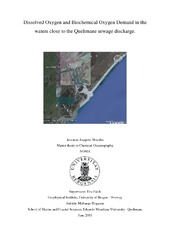Dissolved Oxygen and Biochemical Oxygen Demand in the waters close to the Quelimane sewage discharge
Master thesis
Permanent lenke
https://hdl.handle.net/1956/7063Utgivelsesdato
2010-06-01Metadata
Vis full innførselSamlinger
- Geophysical Institute [1228]
Sammendrag
The River dos Bons Sinais Estuary is one of the most important estuaries in the central region of the Mozambican coast. It is situated between the confluence of Cuácua and Licuári rivers and the Mozambican Channel in the Indian Ocean. The climate is subtropical with the rain season generally from November to April. The domestic wastes from the city of Quelimane are discharged directly into the Bons Sinais Estuary and across from the city there is industrial aquaculture activity. The estuary is also the way of entrance to the port of Quelimane, 20 km away from the ocean. The aim of this study was to analyze the dissolved oxygen and the biochemical oxygen demand in the port of Quelimane, where the discharge of municipal sewage is entering the estuary. BOD indicates the amount of organic matter present in the water. Therefore, a low BOD is an indicator of good quality water, while a high BOD indicates polluted water. The results found during the measuring period indicate that during August dissolved oxygen values were more than critical the value of 2 mg L-1 whereas during September and October dissolved oxygen had values lower than this critical value. The values of biochemical oxygen demand obtained are characteristic of unpolluted waters which suggest that the municipal effluents discharged into the estuary are negligible or are flushed away by the tides.
